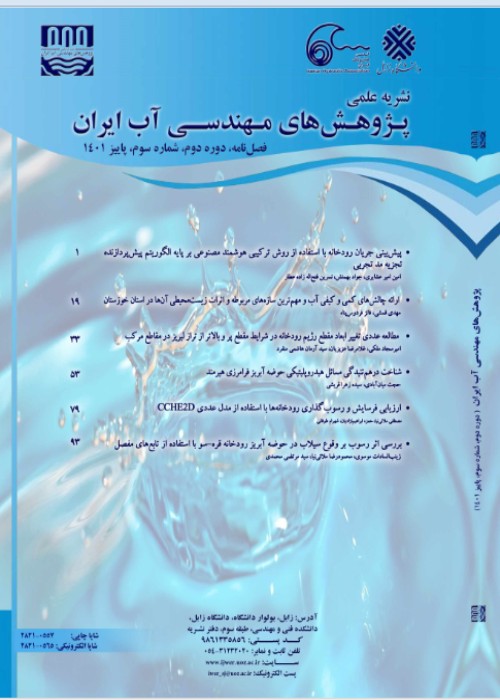Optimization of wastewater pumping system in variable flow conditions with genetic algorithm model and neural network
The sewage pumping station (SPS) serves as the most important structure for the sewage disposal system. The acceptable performances of SPS for reliable design and optimal energy consumption under uncertainties are of great importance for the transformation of wastewater. At a sewage pumping plant, pumps are commonly used on various lines to provide additional head to transport domestic and non-domestic sewage out of towns and villages or to the entrances of treatment plants. Today, the issue of energy management and consumption efficiency is one of the major challenges in water resources and wastewater treatment systems. This dissertation focuses on the planning of sewage pumping energy optimization, which is subject to changes in the rotational speed of the pump and the frequent pattern of inlet flow rate and, the energy consumption of pumping system of Zabol Wastewater treatment plants (WWTPs) was determined and compared using constant speed and optimal speed of pumping rotation. Several models as machine learning approaches were developed to approximate the efficiency of the pumping system in multi-objective optimization approaches (Gao et al., 2012; Marques et al., 2015; Puleo et al., 2014; Wu et al., 2013). It is shown by results from Refs. (Castellet-Viciano et al., 2018; Guo et al., 2014; Molinos-Senante et al., 2013; Pannirselvam and Gopalakrishnan, 2015) that machine learning approaches have high-ability for accurate approximation of energy cost for wastewater treatment. The artificial neural network (ANN) was utilized to estimate the energy efficiency and flow rate for optimization of pumping station (Achieng, 2019; Jamieson et al., 2007; Rao and Alvarruiz, 2007). Using ANN, Rao, and Alvarruiz, 2007 (Rao and Alvarruiz, 2007) approximated the hydrostatic pressures, tank-storage water levels, flow rate, and energy consumption for pumping networks. There conducted that the ANN was reduced the computational burdens about 10-time compared to conventional methods. Using input variables of demand conditions, control settings, and initial starting conditions, Jamieson, 2007 (Jamieson et al., 2007) applied ANN for predictions of storage levels, hydrostatic pressures, and flow rates. Torregrossa et al., 2018 (Torregrossa et al., 2018) simulated the energy consumption using ANN for the pumping station of wastewater and concluded that the ANN was performed with highaccuracy compared to the mathematical relations. For simulating the pumping systems, artificial intelligence techniques are useful tools to reduce computational burdens.optimized the energy of the pumping system using three performance strategies including i) minimizing power consumption, ii) balancing the flow rate, and iii) maximizing efficiency pumping system. Thus, the optimum condition for pumps, which can be determined based on soft computing approach using energy consumption, can be used to approximate the failure modes of SPS in reliability analysis. Therefore, variable speed control was determined for a single-pump pumping station and the optimal rotation speed of the pump was determined using a hybrid optimization model, based on the pump on/off sequence. Then, a machine learning process based on the combined reliability method was developed to estimate the probability of pump failure under the multi-probability performance function and based on the optimal energy conditions of the pumping system. Hourly data measured at Zabol pumping station was generated using the Monte Carlo method based on a probabilistic model in minutes. Comparison of coefficient of determination (R2) of real and computational data showed that the probabilistic normal log model in both Zabol plant of 0.98. In the next step, using the genetic algorithm, the optimal values of the variables of flow rate, load, and power of the pump and thus the efficiency of the pump were calculated. The efficiency resulted from the optimal rotation and the constant rotation for both Zabul stations was 0.86, .In the next step, using the neural network (ANN) model pump rotation speed is simulated based on input variables including pumping flow rate, inlet flow rate, and static height and pumping height. The results showed the accuracy of the models in simulating the pump rotation speed. The value of R2 at the Zabul pumping plant changed from 0.97 to 1 for the ANN method.
-
A second order well-balanced and entropy consistent numerical scheme for one-dimensional shallow water equations
Majid Akbari, *
Journal of Hydraulics, -
Physical hydraulic modeling of gabion stepped weirs with upstream blockage
Sanaz Hasanian, *, Seyed Hossein Rajaei, Mahmood Shafai Bejestan
Journal of Hydraulics,



